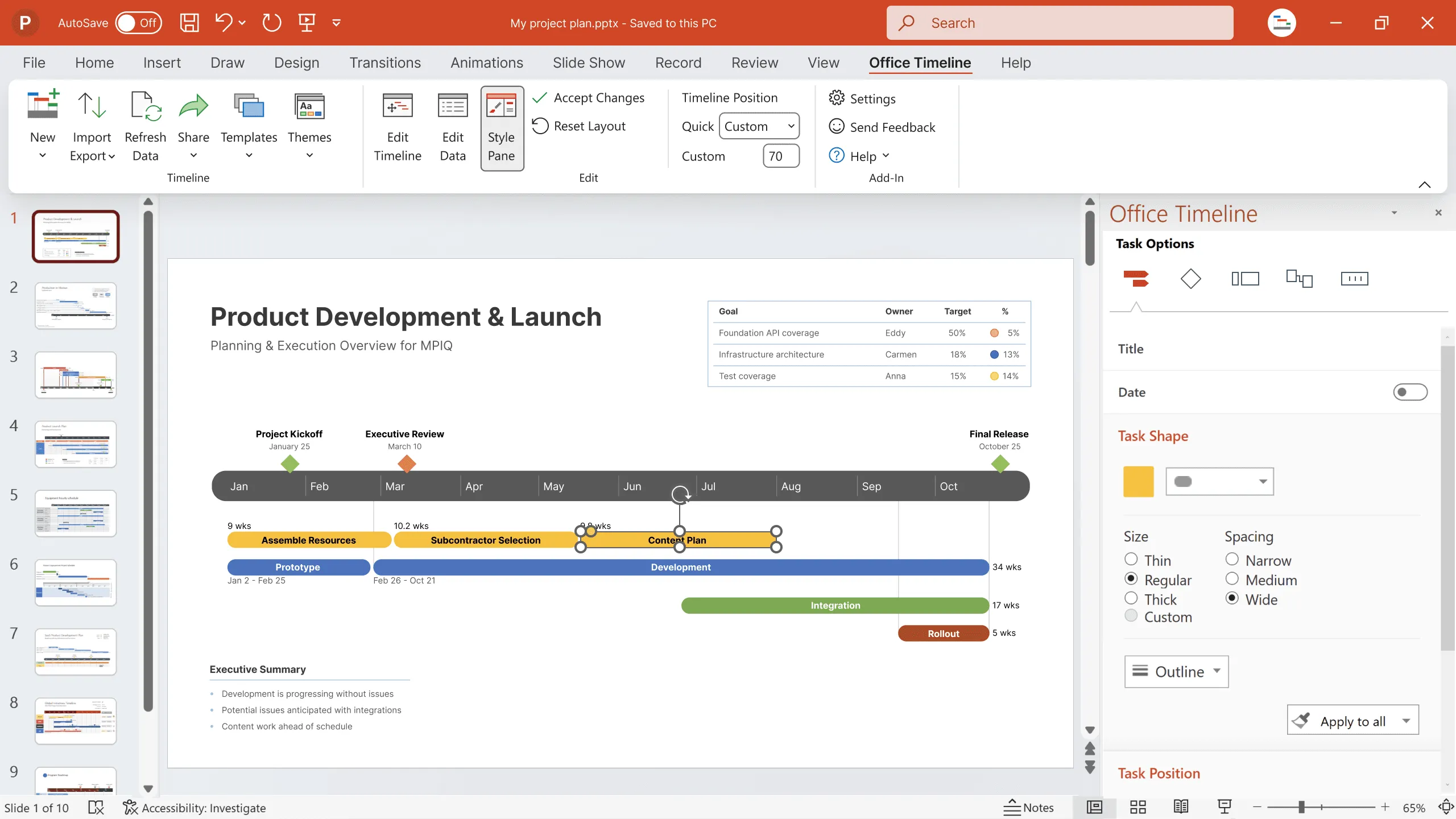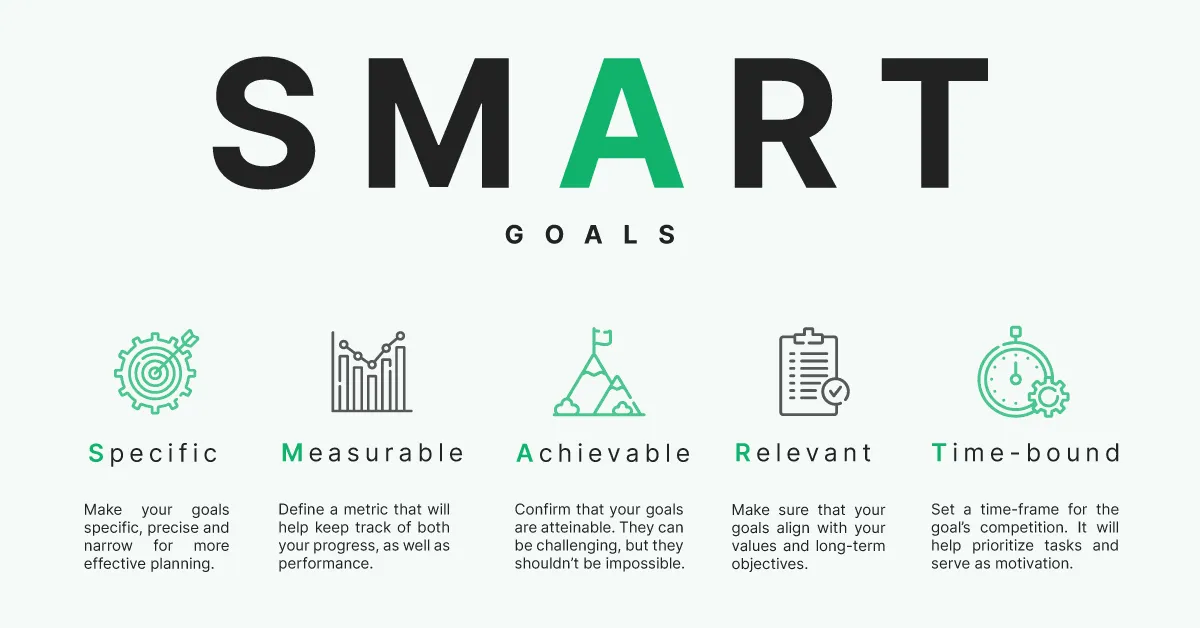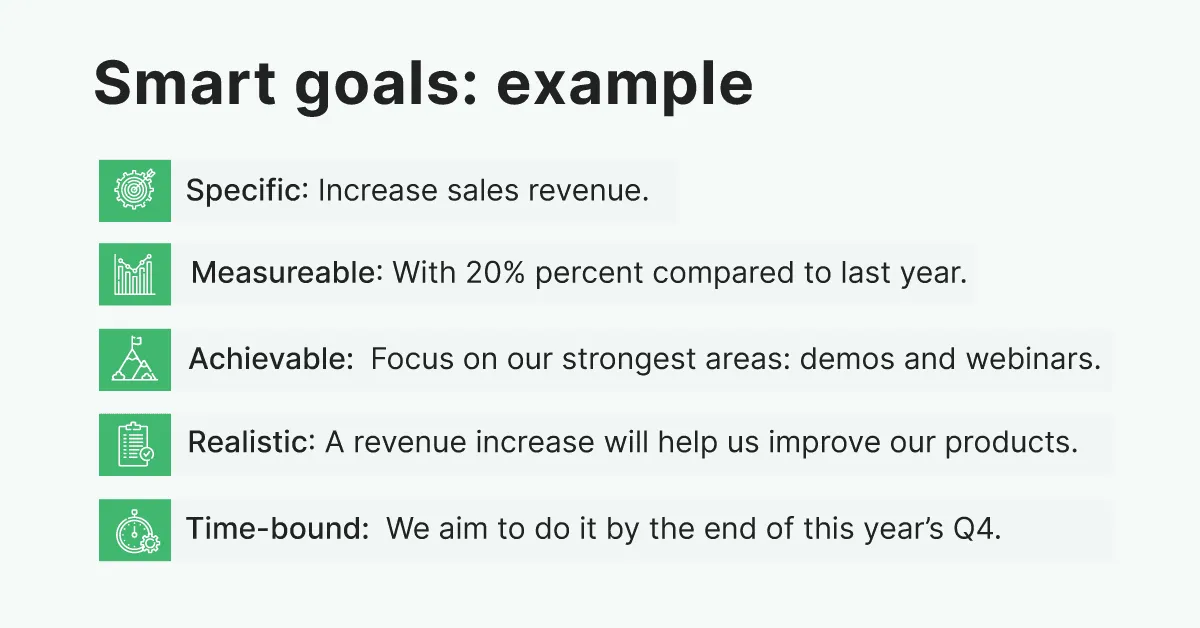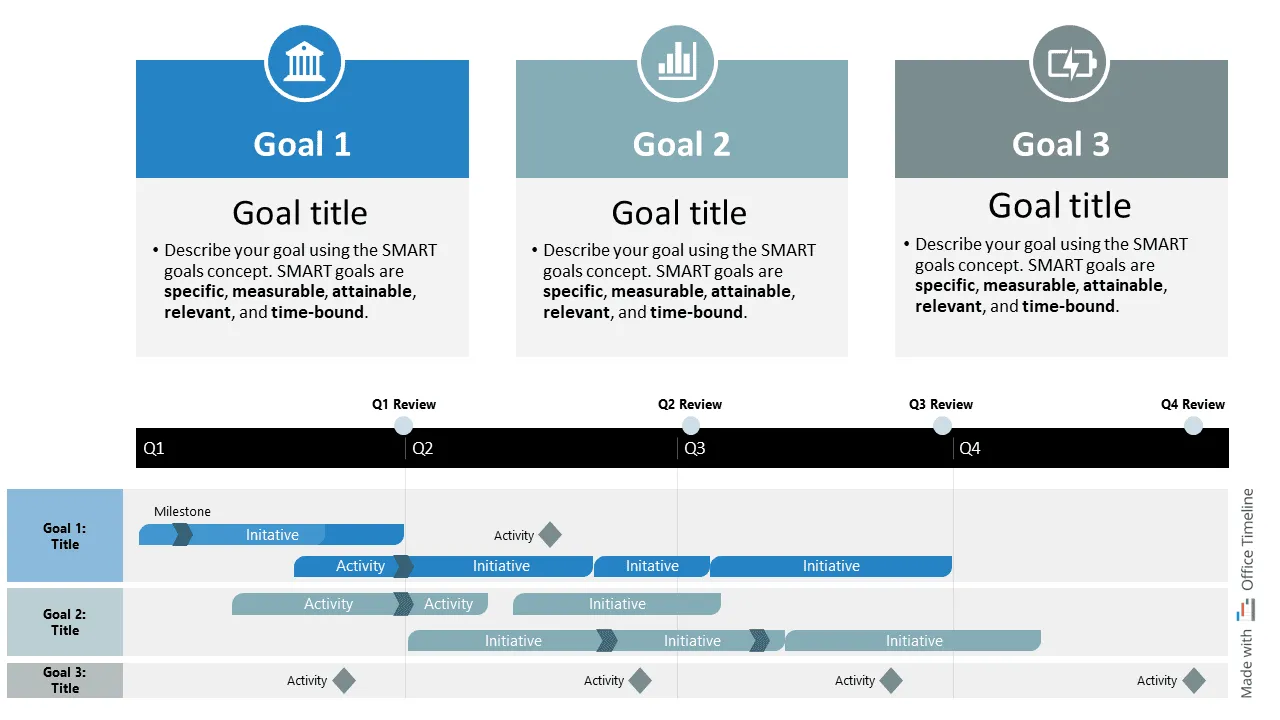SMART goals: the essential guide [+ Free template]
Explore what SMART goals are, why they work, and how to set them. Free PowerPoint template included.

SMART goals represent an excellent way to make effective plans, determine the primary focus, manage obstacles, and remain motivated from start to finish. Numerous studies have highlighted that our projects are considerably more successful when we pursue clearly defined and realistic objectives.
But what is the measure of success in any enterprise? We generally define its success rate by comparing the initial goals set and the outcome. This holds true whether it’s learning a new skill, completing a work task, or kicking a bad habit.
Our first aim is to figure out if our actions are leading us in the desired direction. Secondly, we evaluate how far we are from the set goal, so that we can adjust the approach accordingly. Therefore, goals both define the path and determine progress. This is why they are inextricably linked to success.
If you’re interested in learning more about SMART goals, you’ve come to the right place. We will discuss the underlying concepts behind them, how to set worthwhile objectives correctly and the benefits of this framework. Plus, we’ve included a free timeline template that you can download and use as part of your SMART goal planning strategy.
Let’s get S.M.A.R.T.!
Origins of the SMART goal concept
The history of the SMART acronym begins in 1981 and it is tied to consultant George T. Doran. Along with collaborators Arthur Miller and James Cunningham, Doran published the paper “There’s a S.M.A.R.T. way to write management goals and objectives” in the November 1981 issue of Management Review.
There, he raises the question of how you can write truly meaningful objectives. In George Doran’s view, managers struggle to summarize practical advice from the extensive literature available on the topic. As a solution, he recommends recurring to the SMART acronym whenever someone sits down to write actionable, effective and clear objectives.
Before we elaborate on the SMART goals topic, we must clarify one aspect: not all objectives have to tick every single box in the framework. For instance, there are times when goals that are worth achieving are not measurable, or vice versa. Additionally, you may not need to create an extensive business case when you set a goal for yourself.
To get a better understanding of what this means, let’s kick off by discussing the SMART acronym.
SMART goals acronym
SMART goals can help you achieve the critical results you are working towards. Therefore, a key characteristic is that they promote a clear understanding of the expected performance and desired developments. The SMART acronym defines the following criteria for objectives:
- Specific – clarifies what must be accomplished and steps to take in that direction;
- Measurable – determines the metrics used to evaluate progress;
- Achievable – checks if the required skills and resources are available;
- Relevant – examines the current goal and its importance within the broader context of the overall strategy;
- Time-bound – sets a timeframe for the completion of the goal.
On the surface, these criteria could sound a bit generic and intuitive. After all, whenever you need to decide to whether to engage in an activity or not, you automatically run a cost-benefit calculation. You estimate the time it will take, how feasible it is, whether it’s meaningful to you, etc.
Problems mainly arise when we don’t have a clear understanding of the goal or its implications. The good news is that you can dispel the confusion by putting pen to paper and running your objective through the SMART goals framework.
Let’s examine each of these SMART goals criteria in more detail, to better comprehend their significance and impact.
Why SMART goals should be Specific
We sometimes perceive goals exclusively as the highest of our aspirations and frame them in an ambiguous manner. Inevitably, we become discouraged along the way and quit before we start. For instance, an objective like “becoming fitter” or “better at work” are vague and it’s almost impossible to track your progress.
Specificity in this context marks the path between our current position and the desired destination. It’s essentially the mission statement of the objective. A goal that’s specific goes along the lines of “I would like to do 10 extra push-ups in a single rep” or “I want to take on extra management responsibilities”.
The ability to answer the popular “W” questions is another great indicator for how specific an objective is. These questions include:
- Who – the people involved in reaching this goal;
- What – the exact thing that you intend to achieve;
- When – the estimated timeframe for the completion of the project (you can find out more about this in the time-bound section);
- Where – if the objective is location-based, you should establish it here;
- Which – the resources necessary for completion and the limitations you need to overcome;
- Why – the purpose of setting this objective.
SMART goal examples that tick all these boxes sound like:
“The marketing and development teams (who) want to grow the number of Google App Store (where) downloads by 30% (what) for the next business quarter (when) because audits show a considerably higher engagement on mobile compared to desktop website users (why). We will achieve this by assembling a dedicated interdisciplinary team (which).”
Why SMART goals should be Measurable
Let’s assume that you have selected a goal that is specific enough to answer the above questions. The next stage implies ensuring that your actions are actually guiding you towards its completion. Properly chosen metrics are the key to understanding how you are progressing towards your selected objective. Measuring the correct KPIs eliminates confusion and makes the goal feel tangible.
Depending on the complexity of the objective, the relevant metrics might not always be obvious from the start. To offset this issue, one thing you can do is to first break down the final goal into smaller, actionable tasks. Then, simply mark the completion of each task or subset of tasks with a milestone and you have a way to determine how far you are from its completion.
You don’t necessarily need quantitative measurement methods like the funds you’ve saved or the number of downloads. Qualitative metrics in the vein of customer satisfaction surveys – when applicable – can also be a hint of what success in achieving the goal would look like. The best way to discover the most relevant metrics is to focus on the “why”, i.e., the reason for goal setting in the first place.
Some examples of data types that you can use as metrics include:
- Number of items produced within a specific interval;
- Revenue generated over a specific timeframe;
- Customer satisfaction levels based on a fixed number of surveys;
- Productivity rates determined based on reports and audits.
Why SMART goals should be Achievable
The achievability rule of the SMART goals acronym is the first true reality check. It lives in the sweet spot between what is desirable and what is feasible. Encourage yourself to follow big aspirations, but always remember to balance the long-term goals with the immediate future steps you can take to reach them.
Start by conducting an analysis of the previous goals you’ve achieved. Based on these benchmarks, you can adjust your expectations and write a goal that promotes development without overreaching. Otherwise, it is easy to ignore actual progress, lose momentum and end up discouraged.
Let’s assume that your company’s year on year sales for the past 5 years have grown at a rate of 10%, on average. You could set a goal of raising sales by 100% for the next year, but it is unlikely that you can reach it with conventional, sustainable means. A better approach is to raise the bar by 5% and aim for a 15% year on year sales growth.
To find out if what you’re setting is an achievable goal, try to answer these three questions:
- What steps do I need to take to achieve my goal?
- What skills and resources do I need to achieve my goal?
- What are the constraints and limitations preventing me from achieving my goal?
Finally, take a moment to consider which of the things you’ve discovered are within your control. For instance, an objective like “get a promotion” depends on variables like the number of candidates, their qualifications and the management’s decision. Conversely, SMART goals such as “enrol in a 3-month leadership course and develop the skills to apply for a manager position” are almost entirely up to you.
Why SMART goals should be Relevant
Relevancy is the difference between being busy and being productive. Before you set your eyes on a prize, ask yourself where it sits in your overall strategy. Will it take you one step closer to achieving the things that really matter to you or your company? Is it creating a positive and meaningful impact?
One SMART goal example we can give to better understand this concept is the launch of a new product. Prior to initiating the development campaign, you need to determine how aligned this product is with the company’s portfolio. For instance, an enterprise that operates exclusively as a B2B would reap very limited benefits from releasing a service designed for the consumer market.
You can test out the relevancy of a goal by answering queries such as:
- Is it worth our time and resources?
- Does it stand up in the context of our current strategy?
- Are the current market conditions right for such an endeavour?
- Am I / is my team equipped for such a project?
- Would it be feasible under this economic / political / social climate?
Why SMART goals should be Time-bound
We’ve reached the final rule of the SMART acronym: time-bound. Why is important to set a deadline for your goal? For one thing, deadlines allow you to measure progress in accordance with the original estimates.
Timelines and Gantt charts are an excellent way to visualise the elapsed and remaining timeframes for your deliverables. You can use these graphics to schedule the tasks that you or your team must perform in order to advance your goals.
Depending on how complex your objective is, you might also want to know what partial progress looks like. Milestones are great for this purpose. You can set milestones for the completion of critical tasks or for the completion of a certain project stage.
Creating a sense of urgency is another important reason to ensure your goals have a deadline. Daily routines often end up taking precedent over our goals, which is bound to keep us from moving forward. We can focus our efforts much more easily by breaking down our goal into stages with fixed time allotments.
SMART goals examples
Next, we’re going to look at some actual SMART goals, because when it comes to illustrating a concept, nothing beats examples. More specifically, we’re going to take three real situations where goals must be set. Based on them, we will show you the wrong and right ways to approach them.
SMART goal example 1: Getting in shape
Wrong: “I will exercise more often to improve my overall fitness level”.
Right: “I will go jogging (specific) and use my fitness tracker to monitor my progress (measurable) for at least 20 minutes every other day (achievable) because I want to have a healthier lifestyle (relevant) and to be able to run a full marathon in 6 months from now (time-bound)”.
SMART goal example 2: Expanding a business
Wrong: “My business is turning a decent and stable ROI, so I’m thinking about expanding”.
Right: “I will employ a virtual assistant (specific) to handle direct service enquiries and free up 30% of my time (measurable) so I can work on adding five extra items to our product roster (achievable). My expertise as a developer is more valuable than my customer support skills (relevant). This shift in responsibilities must be done by the end of the business quarter (time-bound).”
SMART goal example 3: Improving a sales team’s performance
Wrong: “I want to help my team increase the number of monthly sales”.
Right: “I will help my team improve the quality of leads (specific) and increase sales by 5% (measurable). Reports indicate at least 1 hour is spent daily on calling customers that aren’t a good match for our products, so better qualifying leads can translate into a sales increase (achievable). This year’s company-wide strategy is to increase overall sales by 15% (relevant) and therefore our aim is to grow our sales by 5% by the end of the fiscal year (time-bound).
How to write SMART goals
Understanding the SMART goals template is only the first step towards success. The role of this framework is to help you find a direction and focus your efforts on that path. However, in order to stay motivated, you also need to make sure the goals set align with your greater aspirations.
Let’s assume that your larger plan involves retiring at the age of 45. To reach this target, your goals must be aimed at earning more money while minimizing unnecessary expenses. As of such, setting an objective along the lines of ‘going on an exotic holiday at least once per year’ would be in contradiction with the overarching narrative.
Five tips for SMART goal setting
Next, let’s explore the 5 golden rules of setting objectives that you’ll actually want to reach.
1. Take your short-term priorities into account when you set SMART objectives.
Motivation is crucial for following through, and you should acknowledge that not every action needed to reach your goal will be easy or pleasant. Nonetheless, knowing what you are “fighting for” and checking off milestone after milestone will keep you on the straight and narrow.
2. Set each of your chosen SMART goals in writing.
It could be tempting to think that you’ll remember all the details because, after all, they are important to you. The problem is that life is full of unexpected situations, some of which must be handled with priority. Staying flexible is not a mistake, but make sure that you return to your goals once the proverbial fires are put out.
3. Frame your objectives using only positive statements.
There is already a lot of negativity in our lives, and that bleeds our motivation and focus. Don’t add to it by creating reminders of the things you don’t want and that you’re attempting to avoid.
4. Pack your SMART goals into larger action plans.
Context enables us to determine if the goals we are setting are consistent with each other and our larger aspirations. At the same time, it allows us to track progress in the larger scheme of things, not just from day to day or month to month.
5. Stick with your objectives, even if it means that sometimes you need to give yourself a push.
Our actions are often guided by habits and routines. Remember that you’ve set those goals to escape the daily grind and build a more rewarding life for yourself.
SMART goals template
As mentioned earlier, timelines and Gantt charts are invaluable planning tools. Whether you’re managing a project at work or your personal agenda, these types of visuals are clear, intuitive and easy to take in. The following SMART goals template was created using Office Timeline and you can download it for free as a fully editable PowerPoint slide.
You can easily customize the visual with your own goals and track progress using the timeline provided. The graphic can be updated manually, but we recommend using Office Timeline’s free trial to take advantage of the tool’s powerful automation engine.
FAQ about SMART goals
Let’s answer some of the most frequently asked questions about the SMART goal framework.
SMART goals are objectives set in accordance with the specific, measurable, achievable, relevant and time-bound framework. You can transform almost any plan into a SMART goal by delving into its details, identifying its success metrics, ensuring that it can be done and that it’s relevant in the context of your other plans, and setting a target date for it.
SMART goals can help you transform your dreams into actionable steps by enabling you to focus your efforts on what is truly important. In addition, goals written using the SMART framework are consistent with your aspirations and allow tracking your progress with ease. SMART goal setting is the first step to success.
Start by asking yourself what it is that you really want to achieve, no matter how difficult or farfetched it seems at the moment. Dream big and be true to yourself. Once you have created an outline of your aspirations, think about what you can do to get there and break down these actions into smaller steps.
First, run your chosen goals through the SMART matrix and ensured they qualify. Next, examine your daily schedule and start making time allotments for the steps you need to take towards your objectives. Whatever goals you’ve decided on, it is important to stick with them, especially when the going gets tough. If you find yourself overwhelmed constantly, it may be time to revisit your SMART objectives plan and perform adjustments. Remember that no one is born with discipline and an iron will. These are traits that you develop and build on, step by step.
Tim is Co-Founder & CEO of Office Timeline, a Seattle-based start-up that aims to rid the world of boring, uninspiring meetings.
Turn project data into professional timelines
Get the advanced features of Office Timeline free for 14 days.





